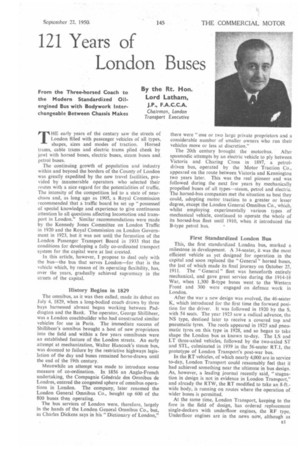121 Years of London Buses
Page 83

If you've noticed an error in this article please click here to report it so we can fix it.
By the Rt. Hon. Lord Latham,
F.A.C.C.A.
Chairman, London Transport Executive From the Three-horsed Coach to the Modern Standardized Oilengined Bus with Bodywork Interchangeable Between Chassis Makes
THE early years of the century saw the streets of London filled with passenger vehicles of all types, shapes, sizes and modes of traction. Horsed trains, cable trams and electric trams plied cheek by jowl with horsed buses, electric buses, steam buses and, petrol buses.
The continuing growth of population and industry within and beyond the borders of the County of London was greatly expedited by the new travel facilities, provided by innumerable operators who selected their routes with a nice regard for the potentialities of traffic. The intensity of the competition led to a state of nearchaos and, as long ago as 1905, a Royal Commission recommended that a traffic board be set up "possessed of special knowledge and experience to give continuous attention 'to all questions affecting locomotion and transport in London." Similar recommendations were made by the Kennedy Jones Committee on London Traffic in 1920 and the Royal Commission on London Government in 1923, but it was not until the formation of the London Passenger Transport Board in 1933 that the conditions for developing a fully co-ordinated transport system for the capital were at last created.
In this article, however, I propose to deal only with the bus—the bus that serves London—for that is the vehicle which, by reason of its operating flexibility, has, over the years, gradually achieved supremacy in the streets of the capital.
History Begins in 1829
The omnibus, as it was then called, made its debut on July 4, 1829, when a long-bodied coach drawn by three bays harnessed abreast began working between Paddington and the Bank. The operator, George Shillibeer, was a London coachbuilder who had constructed similar vehicles for use in Paris. The immediate success of Shillibeer's omnibus brought a host of new proprietors into the field and within a few years omnibuses were an established feature of the London streets. An early attempt at mechanization, Walter Hancock's steam bus, was doomed to failure by the restrictive highways legislation of the day and buses remained horse-drawn until the end of the 19th century.
Meanwhile an attempt was made to introduce some measure of co-ordination. In 1856 an Anglo-French undertaking, the Compagnie Gentrale des Omnibus de Londres, entered the congested sphere of omnibus operations in London. The company, later renamed the London General Omnibus Co., bought up 600 of the 800 buses then operating.
The bus services of London were, therefore, largely in the hands of the London General Omnibus Co., but, as Charles Dickens says in his "Dictionary of London," there were "one or two large private proprietors and a considerable number of smaller owners who run their vehicles more or less at discretion."
The 20th century brought the motorbus. After spasmodic attempts by an electric vehicle to ply between Victoria and Charing Cross in 1897, a petroldriven bus, operated by the Motor Traction Co., appeared on the route between Victoria and Kennington two years later. This was the real pioneer and was followed during the next few years by mechanically propelled buses of all types—steam, petrol and electric. The horsed-bus companies met the situation as best they could, adopting motor traction to a greater or lesser degree, except the London General Omnibus Co., which, whilst employing experimentally various types of mechanical vehicle, continued to operate the whole of its horsed-bus fleet until 1910, when it introduced the B-type petrol bus. • First Standardized London Bus
This, the first standardized London bus, marked a milestone in development. A 34-seater, it was the most efficient vehicle as yet designed for operation in the capital and soon replaced the "General" horsed buses, the last of which made its final journey on October 25, 1911. The "General" fleet was henceforth entirely mechanical, and gave great service during the 1914-18 War, when 1,300 B-type buses went to the Western Front and 300 were engaged on defence work in London.
After the war a new design was evolved, the 46-seater K, which introduced for the first time the forward position for the driver. It was followed in 1920 by the S, with 54 seats. The year 1923 saw a radical advance, the NS type, destined later to receive a covered top and pneumatic tyres. The roofs appeared in 1925 and pneumatic tyres on this type in 1928, and so began to take shape the London bus as known to-day. The LS and LT three-axled vehicles, followed by the two-axled ST and STL, culminated in 1939 in the 56-seater RT.1, the prototype of London Transport's post-war bus.
In the RT vehicles, of which nearly 4,000 are in service to-day, London Transport could reasonably feel that it had achieved something near the ultimate in bus design. As, however, a leading journal recently said, "stagnation in design is not in evidence in London Transport," and already the RTW, the RT modified to take an 8-ft.wide body, is running on routes where the operation of wider buses is permitted.
At the same time, London Transport, keeping to the fore in the field of design, has ordered replacement single-deckers with underfloor engines, the RF type. Underfloor engines are in the news now, although as




































































































































































































































































